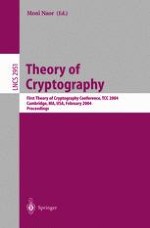2004 | Buch
Theory of Cryptography
First Theory of Cryptography Conference, TCC 2004, Cambridge, MA, USA, February 19-21, 2004. Proceedings
herausgegeben von: Moni Naor
Verlag: Springer Berlin Heidelberg
Buchreihe : Lecture Notes in Computer Science
Enthalten in: Professional Book Archive
